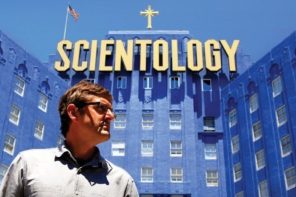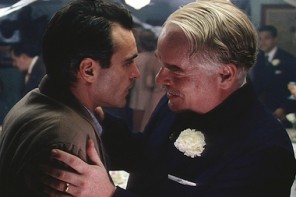Since its first incorporation in 1953, the Church of Scientology has fought wars on many fronts: against the IRS and other government agencies, against anti-cult activists, against former members, against various Web sites disseminating confidential church materials online, and, perhaps most sensationally, against the American media.
Not long after its founder L. Ron Hubbard published his bestselling self-help book Dianetics in 1950, the movement became the subject of often withering critiques by a wide range of journalists. And for the next sixty years it was the focus of exposés in various publications, from Life, to the Los Angeles Times, the New York Times, Reader’s Digest, Penthouse, and Time, not to mention numerous television documentaries (and a satirical episode of South Park).
One of the most devastating reports on the church, however, was a recent series in the St. Petersburg Times by Joe Childs and Thomas C. Tobin entitled “The Truth Rundown. ” Focused on the church’s current head, David Miscavige, the report and video interviews with ex-members describe a “culture of violence of intimidation” that pervades the very highest levels of the church’s hierarchy. The material presented in Childs’ and Tobins’ report ranges from the shocking to the downright bizarre, including allegations that Miscavige physically beat his senior executives and (in what is among the most astonishing incidents in the history of American religions) forced executives to play a brutal, all-night game of musical chairs to the tune of Queen’s “Bohemian Rhapsody.” In response, however, the church has argued that this is simply one more example in a long history of biased, unfounded media attacks against a legitimate religious organization.
But if Scientology is today infamous because of its negative media attention, it is perhaps even more so because of its aggressive response to journalists who write critically about the church. As Time magazine’s Richard Behar put it in 1991, “strange things happen to people who write about Scientology,” including massive litigation, private investigations, and personal attacks that have at times bordered on the surreal.
In February of this year, however, we learned from the Washington Post that the Church of Scientology has made a surprising new move. Rather than immediately threatening the St. Petersburg Times with lawsuits for its “Truth Rundown” report, the church adopted a different strategy: it hired three prominent journalists (a Pulitzer Prize winner, a former 60 Minutes producer, and the former executive director of Investigative Reporters and Editors) to undertake their own investigation of the Times and the conduct of Childs and Tobin.
This new move is at once in continuity with Scientology’s longstanding war with the American media and the signal of an important shift in its battle plan. Once known for its aggressive practice of using lawsuits and extra-legal measures against critics, the church now appears to be trying to use the media against itself.
Tricked, Sued, Lied To, or Destroyed
Hubbard’s troubles with the press began almost immediately upon the publication of Dianetics first in the May 1950 issue of Astounding Science Fiction and then in book form that same year. One of the first reviews of the book appeared in The New Republic in 1950, describing Hubbard’s new science of the mind as a remarkably “bold and immodest mixture of complete nonsense and perfectly reasonable common sense, taken from long-acknowledged findings and disguised and distorted by a crazy, newly invented terminology.”
Equally severe criticisms followed throughout the 1950s as his newly-founded Church of Scientology grew in numbers and also attracted increasing scrutiny from the FDA, FBI, IRS, and other government agencies. Hubbard’s response to his critics was equally colorful. As he infamously wrote in his Manual of Justice in 1959: “People attack Scientology; I never forget it, always even the score.” Perhaps the most controversial form of Scientology’s response to its critics was a policy called “fair game,” first announced in 1965. According to Hubbard, enemies of Scientology are to be regarded simply as “fair game”; meaning that they may be countered using any and all means at the church’s disposal. Indeed, those labeled “fair game” may be “tricked, sued, lied to or destroyed.”
Although the use of the phrase “fair game” was officially discontinued in 1968, most critics believe that the policy has effectively continued in practice to this day. In the late 1960s and ’70s, the church created its own intelligence branch called the Guardian’s Office (GO) headed by Hubbard’s wife, Mary Sue, and dedicated to public relations and information control. More than one observer has compared the GO to the CIA for its power to maintain and control secrets, and even one CIA officer compared GO intelligence operations to those of the FBI.
Among the most remarkable examples of the GO’s response to the media was a program entitled “Operation Freakout,” which was launched against journalist Paulette Cooper because of her scathing book, The Scandal of Scientology (1971). According to documents obtained by an FBI raid, the operation was designed to do nothing less than to get Cooper “incarcerated in a mental institution or jail.” The “freakout” was to be accomplished by making fake bomb threats against the church and, if that failed, to frame Cooper for attempting to bomb Henry Kissinger.
The GO was officially dismantled in 1983 after a massive FBI raid that resulted in the conviction of Mary Sue Hubbard and other high-ranking Scientologists, though the church’s war with the media continued throughout the 1980s and ’90s. A pivotal moment came in 1991 with the publication of Richard Behar’s scathing cover story on the Church of Scientology for Time magazine. With the unapologetic title, “The Thriving Cult of Greed and Power,” Behar’s article described the church as primarily a vicious, manipulative, money-driven “racket” that operates in a “mafia-like manner” even as it hides behind the protective, tax-exempt façade of a “religion.”
In a sidebar to the article, however, Behar also recounted the church’s aggressive attempts to obstruct his investigation. At least ten attorneys and six private detectives had been unleashed in an effort to “threaten, harass and discredit” him. Among other things, Behar claims that a copy of his personal credit report—with detailed information about his bank account, credit cards, home address and social security number—was illegally retrieved, and that he was subjected to surveillance and phone-tapping.
The church, meanwhile, countered that Behar’s article was a slanderous, sensationalist attack on a legitimate religious organization and part of a much longer history of misunderstanding and persecution that this religious minority has faced since its inception. In keeping with Scientology’s aggressive response to its critics, the church hit Behar and Time Warner with a libel suit, asking for $416 million in damages. The courts, however, dealt Scientology a devastating blow: by 1996, all counts of the libel suit had been dismissed, and in 2001, a Federal Court of Appeals upheld the dismissal.
Ignoring South Park
Scientology’s defeat in the Behar case (along with several other scandals that occurred at roughly the same time, such as the highly controversial death of Scientologist Lisa McPherson) appears to have marked a significant shift in the church’s response to its critics. To the surprise of anyone who follows Scientology and its history of “fair game,” the church did virtually nothing after South Park aired a viciously satirical episode in 2005. The episode not only ridiculed Hubbard and his celebrity followers such as Tom Cruise but, amazingly, also revealed the most highly confidential level of the church’s advanced technology known as “OT III,” which contains the secret history of the cosmos and the origin of human suffering. The fact that Scientology left South Park untouched by even the threat of a lawsuit signals a clear tactical shift.
Given this history of the church’s dealings with the media, we can see both the continuities and the important differences in its current strategy for responding to the St. Petersburg Times. The tactics of “fair game” and “Operation Freakout” appear to have been very costly to the church, both financially and for public relations. Instead, it has now apparently brought three well-known journalists onto its own payroll.
According to the Washington Times, the church offered $5,000 to Steve Weinberg (the former executive of Investigative Researchers and Editors, who has taught at the University of Missouri’s journalism school for a quarter-century) to edit the study. The other journalists commissioned include Russell Carollo, who won a 1998 Pulitzer Prize, and Christopher Szechenyi, an Emmy-winning former television producer. The church declines to say how much Carollo and Szechenyi were paid but states that it simply wants an “outside view” of the situation. The result of the investigation is reportedly a twenty-page document that is said by the church to be “highly critical” of the Times; yet it is by no means clear when—or indeed if—the study will be released.
What is at stake for both sides is more than simply a war of words or even a costly lawsuit. For Scientology, as church spokesman Tommy Davis argues, this is a matter of religious freedom in the face of relentless media persecution and “naked bias” against “the fastest-growing religion on Earth.” In response to the “Truth Rundown,” Scientology’s Freedom magazine published a long rebuttal, claiming that the Times “had written hundreds of derogatory articles about the Scientology religion, consistently pounding the Church, its members and leaders with vituperative rumor, innuendo and allegation, all of which resulted in a hostile environment for the Church.”
For the Times and other journalists, conversely, this is a matter of journalistic ethics and free speech. As the Times’ executive editor Neil Brown argues, a study that is effectively “bought and paid for by the Church of Scientology” could not possibly be objective; moreover it is to him surprising and disappointing that fellow journalists would take money to investigate a paper “while they’re being paid to ask these questions by the very subjects of [its] reporting.”
It remains unclear what will become of the study commissioned by the church, whether it will be invoked in some future lawsuit or simply filed away. In either case, it is telling evidence that strange things continue to happen to people who write about Scientology; but they are taking on surprising new forms as the church adapts to a new world of information.




